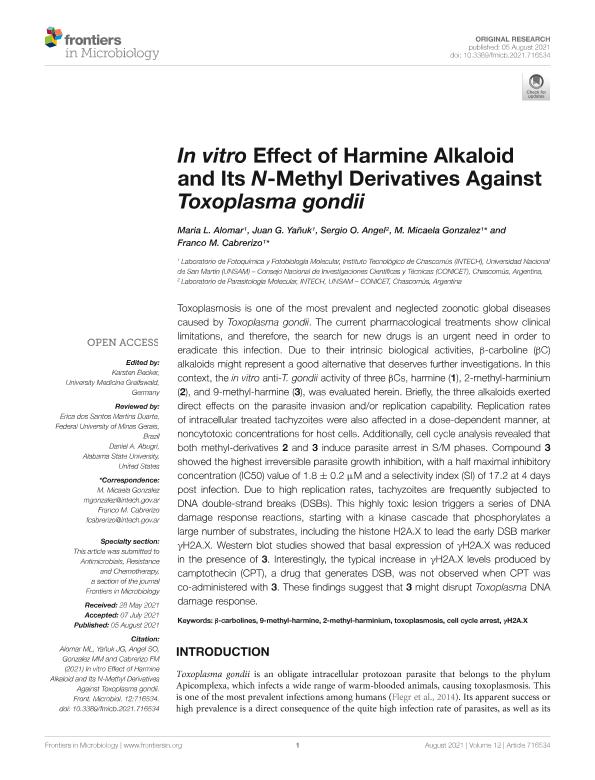Mostrar el registro sencillo del ítem
dc.contributor.author
Alomar, María Lis

dc.contributor.author
Yañuk, Juan Gabriel

dc.contributor.author
Angel, Sergio Oscar

dc.contributor.author
Gonzalez, Maria Micaela

dc.contributor.author
Cabrerizo, Franco Martín

dc.date.available
2023-08-23T13:44:43Z
dc.date.issued
2021-08
dc.identifier.citation
Alomar, María Lis; Yañuk, Juan Gabriel; Angel, Sergio Oscar; Gonzalez, Maria Micaela; Cabrerizo, Franco Martín; In vitro Effect of Harmine Alkaloid and Its N-Methyl Derivatives Against Toxoplasma gondii; Frontiers Media; Frontiers in Microbiology; 12; 716534; 8-2021; 1-12
dc.identifier.uri
http://hdl.handle.net/11336/209054
dc.description.abstract
Toxoplasmosis is one of the most prevalent and neglected zoonotic global diseases caused by Toxoplasma gondii. The current pharmacological treatments show clinical limitations, and therefore, the search for new drugs is an urgent need in order to eradicate this infection. Due to their intrinsic biological activities, β-carboline (βC) alkaloids might represent a good alternative that deserves further investigations. In this context, the in vitro anti-T. gondii activity of three βCs, harmine (1), 2-methyl-harminium (2), and 9-methyl-harmine (3), was evaluated herein. Briefly, the three alkaloids exerted direct effects on the parasite invasion and/or replication capability. Replication rates of intracellular treated tachyzoites were also affected in a dose-dependent manner, at noncytotoxic concentrations for host cells. Additionally, cell cycle analysis revealed that both methyl-derivatives 2 and 3 induce parasite arrest in S/M phases. Compound 3 showed the highest irreversible parasite growth inhibition, with a half maximal inhibitory concentration (IC50) value of 1.8 ± 0.2 μM and a selectivity index (SI) of 17.2 at 4 days post infection. Due to high replication rates, tachyzoites are frequently subjected to DNA double-strand breaks (DSBs). This highly toxic lesion triggers a series of DNA damage response reactions, starting with a kinase cascade that phosphorylates a large number of substrates, including the histone H2A.X to lead the early DSB marker γH2A.X. Western blot studies showed that basal expression of γH2A.X was reduced in the presence of 3. Interestingly, the typical increase in γH2A.X levels produced by camptothecin (CPT), a drug that generates DSB, was not observed when CPT was co-administered with 3. These findings suggest that 3 might disrupt Toxoplasma DNA damage response.
dc.format
application/pdf
dc.language.iso
eng
dc.publisher
Frontiers Media

dc.rights
info:eu-repo/semantics/openAccess
dc.rights.uri
https://creativecommons.org/licenses/by/2.5/ar/
dc.subject
2-METHYL-HARMINIUM
dc.subject
9-METHYL-HARMINE
dc.subject
CELL CYCLE ARREST
dc.subject
TOXOPLASMOSIS
dc.subject
Β-CARBOLINES
dc.subject
ΓH2A.X
dc.subject.classification
Otras Ciencias Químicas

dc.subject.classification
Ciencias Químicas

dc.subject.classification
CIENCIAS NATURALES Y EXACTAS

dc.title
In vitro Effect of Harmine Alkaloid and Its N-Methyl Derivatives Against Toxoplasma gondii
dc.type
info:eu-repo/semantics/article
dc.type
info:ar-repo/semantics/artículo
dc.type
info:eu-repo/semantics/publishedVersion
dc.date.updated
2023-08-15T23:06:53Z
dc.identifier.eissn
1664-302X
dc.journal.volume
12
dc.journal.number
716534
dc.journal.pagination
1-12
dc.journal.pais
Suiza

dc.journal.ciudad
Lausana
dc.description.fil
Fil: Alomar, María Lis. Consejo Nacional de Investigaciones Científicas y Técnicas. Centro Científico Tecnológico Conicet - La Plata. Instituto de Investigaciones Biotecnológicas. Instituto de Investigaciones Biotecnológicas "Dr. Raúl Alfonsín" (sede Chascomús). Universidad Nacional de San Martín. Instituto de Investigaciones Biotecnológicas. Instituto de Investigaciones Biotecnológicas "Dr. Raúl Alfonsín" (sede Chascomús); Argentina
dc.description.fil
Fil: Yañuk, Juan Gabriel. Consejo Nacional de Investigaciones Científicas y Técnicas. Centro Científico Tecnológico Conicet - La Plata. Instituto de Investigaciones Biotecnológicas. Instituto de Investigaciones Biotecnológicas "Dr. Raúl Alfonsín" (sede Chascomús). Universidad Nacional de San Martín. Instituto de Investigaciones Biotecnológicas. Instituto de Investigaciones Biotecnológicas "Dr. Raúl Alfonsín" (sede Chascomús); Argentina
dc.description.fil
Fil: Angel, Sergio Oscar. Consejo Nacional de Investigaciones Científicas y Técnicas. Centro Científico Tecnológico Conicet - La Plata. Instituto de Investigaciones Biotecnológicas. Instituto de Investigaciones Biotecnológicas "Dr. Raúl Alfonsín" (sede Chascomús). Universidad Nacional de San Martín. Instituto de Investigaciones Biotecnológicas. Instituto de Investigaciones Biotecnológicas "Dr. Raúl Alfonsín" (sede Chascomús); Argentina
dc.description.fil
Fil: Gonzalez, Maria Micaela. Consejo Nacional de Investigaciones Científicas y Técnicas. Centro Científico Tecnológico Conicet - La Plata. Instituto de Investigaciones Biotecnológicas. Instituto de Investigaciones Biotecnológicas "Dr. Raúl Alfonsín" (sede Chascomús). Universidad Nacional de San Martín. Instituto de Investigaciones Biotecnológicas. Instituto de Investigaciones Biotecnológicas "Dr. Raúl Alfonsín" (sede Chascomús); Argentina
dc.description.fil
Fil: Cabrerizo, Franco Martín. Consejo Nacional de Investigaciones Científicas y Técnicas. Centro Científico Tecnológico Conicet - La Plata. Instituto de Investigaciones Biotecnológicas. Instituto de Investigaciones Biotecnológicas "Dr. Raúl Alfonsín" (sede Chascomús). Universidad Nacional de San Martín. Instituto de Investigaciones Biotecnológicas. Instituto de Investigaciones Biotecnológicas "Dr. Raúl Alfonsín" (sede Chascomús); Argentina
dc.journal.title
Frontiers in Microbiology
dc.relation.alternativeid
info:eu-repo/semantics/altIdentifier/url/https://www.frontiersin.org/articles/10.3389/fmicb.2021.716534/full
dc.relation.alternativeid
info:eu-repo/semantics/altIdentifier/doi/https://doi.org/10.3389/fmicb.2021.716534
Archivos asociados
